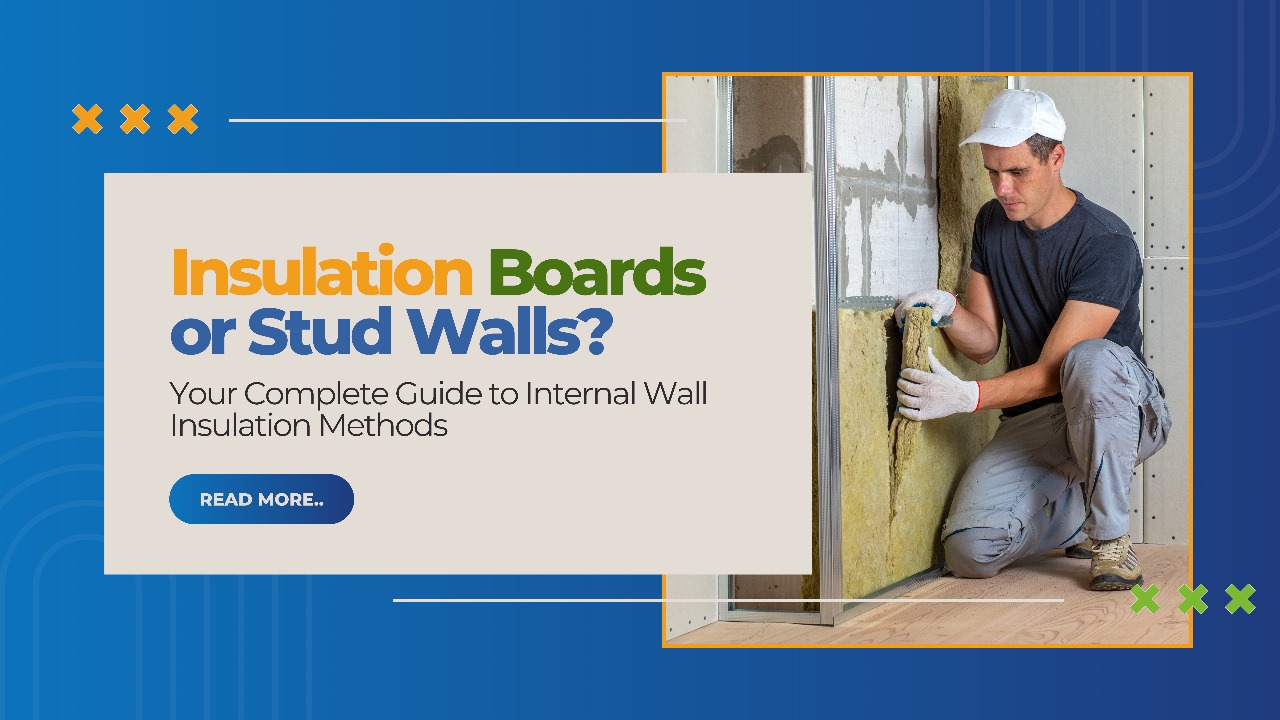
Insulation Boards or Stud Walls? Your Complete Guide to Internal Wall Insulation Methods
If you're considering internal wall insulation for your solid wall property, you've already taken the crucial first step toward a warmer, more energy-efficient home. However, with various installation methods available, how do you determine which approach is best suited for your property? This comprehensive guide breaks down the two primary internal wall insulation techniques, helping you make an informed decision that aligns with your home's needs and your lifestyle.
Understanding Internal Wall Insulation: Why Method Matters
Internal Wall Insulation (IWI) involves adding insulation material to the interior surface of external walls, creating a thermal barrier that significantly reduces heat loss. For solid-wall properties—common in pre-1920s homes—this can cut heating costs by up to 45% while eliminating cold spots and draughts. However, the method of installation can impact everything from room dimensions to wall functionality, and choosing between insulation boards and stud walls is particularly important.
Method 1: Insulation Boards – The Precision Engineering Approach
How It Works:
Insulation boards consist of rigid panels made from materials like polyisocyanurate (PIR), phenolic foam, or mineral wool. These boards are directly bonded to your existing wall using special adhesives, then finished with plasterboard and a vapour control layer to prevent condensation.
Technical Advantages:
- Superior Thermal Performance: Modern insulation boards offer exceptional U-values (as low as 0.20-0.25 W/m²K), meaning outstanding heat retention
- Minimal Space Loss: With thicknesses ranging from 50mm to 120mm, this is the most space-efficient option
- Vapour Control: Many systems include integrated vapour barriers, crucial for preventing interstitial condensation
- Rapid Installation: Typically 30-40% faster than stud wall methods
Practical Benefits:
- Clean Lines: Creates smooth, seamless walls ideal for contemporary interiors
- Moisture Resistance: Particularly suitable for kitchens and bathrooms where humidity fluctuates
- Fire Performance: Many boards carry excellent fire ratings (Class 0 or Class 1)
Considerations:
- Requires relatively even wall surfaces for optimal performance
- Limited capacity for concealing services without additional boxing
- May need supplementary fixings for heavy wall-mounted items
Best Suited For:
- Period properties where preserving room proportions is important
- Homes with relatively even existing walls
- Rooms where maximum space retention is crucial
Method 2: Insulated Stud Walls – The Flexible Framework Solution
How It Works:
This traditional method involves constructing a timber or metal frame (studwork) against your existing wall. The cavities between the studs are filled with insulation material—typically mineral wool, sheep's wool, or rigid boards—before being sealed with plasterboard.
Technical Advantages:
- Exceptional Acoustic Performance: The deep cavity and dense insulation provide superior soundproofing
- Handles Irregular Walls: Can accommodate significant wall unevenness and variations
- Service Integration: Easy routing of electrical wiring, pipes, and other services within the cavity
- Proven Longevity: Well-established method with decades of successful applications
Practical Benefits:
- Load-Bearing Capacity: Can support heavy wall-mounted units, televisions, or shelving
- Breathability: Natural insulation materials maintain wall permeability, which is important for some traditional properties
- Flexible Design: Allows for creative features like recessed shelving or niche spaces
Considerations:
- Greater space loss—typically 100-150mm from the existing wall
- Longer installation time due to multiple construction stages
- Requires careful attention to airtightness detailing
Best Suited For:
- Very uneven or irregular wall surfaces
- Rooms requiring significant soundproofing
- Spaces where concealing services are a priority
- Traditional properties where wall breathability is important
Making the Right Choice: Key Decision Factors
1. Property Type and Condition:
- Victorian/Edwardian Homes: Often suit stud walls due to typically uneven walls
- 1930s Semis: Frequently work well with insulation boards, given more uniform construction
- Listed Buildings: May require specific approaches—consult conservation specialists
2. Room Usage:
- Living Rooms/Bedrooms: Either method can work well
- Kitchens/Bathrooms: Insulation boards are often preferred for moisture resistance
- Home Offices: Stud walls offer better acoustic performance
3. Practical Considerations:
- Space vs Function: Balance room size reduction against the need for service concealment
- Future Plans: Consider whether you might want to mount heavy items on walls
- Budget: While ECO4 grants cover both methods, material costs differ
Professional Assessment: The Crucial Next Step
While this guide provides comprehensive information, nothing replaces a professional survey. Our certified assessors consider multiple factors when recommending the optimal solution:
- Wall Condition: Moisture levels, existing finishes, and structural integrity
- Thermal Bridging: Identifying and addressing cold bridges around openings and junctions
- Airtightness Strategy: Ensuring continuous air barrier performance
- Building Regulations: Compliance with Part L (conservation of fuel and power)
The Installation Process: What to Expect
For Insulation Boards:
- Surface preparation and damp proofing
- Application of adhesive and board fixing
- Sealing of joints and perimeter gaps
- Plasterboard installation and finishing
- Decoration-ready surface
For Stud Walls:
- Framework construction with appropriate spacing
- Insulation installation between studs
- Vapour control layer application
- Service installation and testing
- Plasterboard fixing and finishing
Funding Your Installation Through ECO4
The excellent news is that both insulation methods are fully covered under the government's ECO4 scheme, provided you meet the eligibility criteria. This includes:
- Homeowners and private tenants (with landlord permission)
- Households receiving qualifying benefits
- Properties with solid walls and poor energy efficiency
Our team handles the entire grant application process, making your journey to a warmer home completely hassle-free.
Take the Next Step Toward a Warmer Home
Understanding the differences between insulation methods empowers you to participate knowledgeably in decisions about your home's improvement. Both approaches will dramatically enhance your comfort and reduce your energy bills—the choice depends on which solution best matches your property's characteristics and your family's needs.
Ready to determine the perfect insulation solution for your home? Or speak with our technical specialists: 020-8050-8100
At Zero Carbon Plans, we combine technical expertise with practical understanding to recommend the ideal insulation strategy tailored to your specific circumstances. Let us help you transform your solid wall property into the warm, efficient home you deserve.
